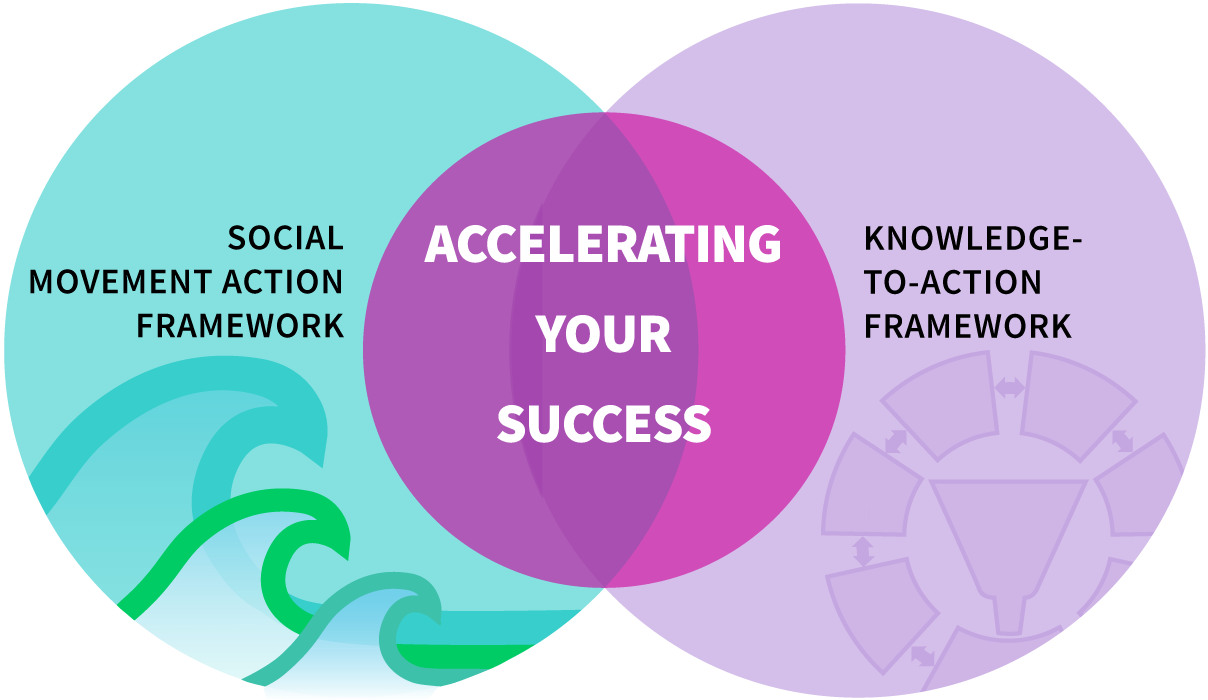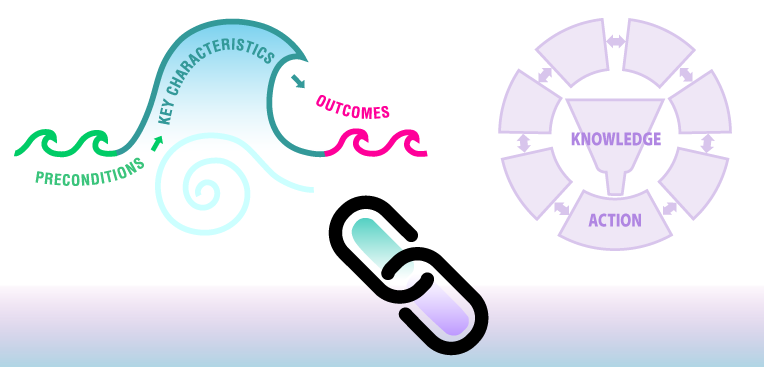

Welcome to the Leading Change Toolkit™! This toolkit is designed for change teams and change agents who are leading a change initiative and to give them what they need to be effective such as practical tips, templates, tools and strategies.
The Leading Change Toolkit™ features two complementary evidence-based frameworks, as shown in the Venn diagram above: the Social Movement Action (SMA) Framework (Grinspun et al., 2020; Leading change through social movement) and the Knowledge-To-Action (KTA) Framework (Graham et al., 2006). To get started on the path to success, you can use both of these implementation frameworks as tools to guide your process.
How do the SMA and KTA Frameworks overlap?
The SMA and KTA Frameworks are both dynamic, responsive and powerful approaches to change. Both frameworks:
- support the uptake and sustainability of knowledge to create innovation
- lead to positive and lasting outcomes, such as quality improvement, patient safety and excellence in care
Both frameworks also require engaged leadership by change agents and/or change teams, and other stakeholders, including persons/patients and their families.
When combined, the SMA and KTA Frameworks provide change agents and change teams a novel strategy to implementation that pairs:
- grassroots actions in response to an urgent shared concern and/or a strongly desired change (SMA Framework); and
- a systematic and structured approach to an identified problem (KTA Framework).
What do I need to know about each framework?
Here are some key points about each framework.
Social Movement Action: The SMA Framework is a people-led "bottom-up" approach to practice change. This approach develops in response to a strong desire for change or a shared concern, and a readiness for action.
The SMA Framework includes many components of social movements that have demonstrated impact and long-term benefits on evidence uptake and sustainability. The framework’s 16 elements are structured according to three broad timepoints:
- Preconditions: the conditions that must be in place prior to the social movement;
- Key Characteristics: the features that must be present for a social movement to occur; and
- Outcomes: the results emanating from the social movement undertaken.
Knowledge-to-Action: The KTA Framework is a planned, structured and cyclical approach to change that integrates two related components:
- knowledge creation; and
- an action cycle consisting of seven phases: identifying; adapting; assessing; selecting; monitoring; evaluating; and sustaining.
Why should I consider combining both frameworks in my change initiative?
Both frameworks are flexible and effective at supporting and accelerating change initiatives. Reasons for combining these two complementary approaches in your change initiative include:
- speeding up the change process because of the combined effects of two approaches that apply knowledge from two different disciplines, health and social sciences;
- promoting greater collaboration between change agents by breaking down the hierarchies and individual silos of traditional top-down methods such as those in the KTA Framework;
- reducing barriers to change by engaging both formal leaders through elements of the KTA Framework and informal leaders through elements of the SMA Framework;
- supporting the creation of positive evidence-based outcomes at multiple levels - micro (individual) meso (organizational), and system (macro); and
- making lasting change and improvements by furthering the capacity of change agents to expand their knowledge, skills and actions.

Linkages to specific approaches or strategies of one framework to the other
We use this linking icon throughout sections of the Leading Change Toolkit™ to highlight any component relevant to both frameworks. You can use specific approaches from the other framework to build upon your approach to change.
|
Image
 |
The SMA Framework includes 16 sections – three Preconditions, 10 Key Characteristics and three Outcomes. The KTA Framework includes seven sections, one for each of the action cycle phases. We describe examples of linkages between the frameworks’ elements and action cycle phases in the "Linking this element [or action cycle phase] to other framework components" section. |
What else should I know about linkages?
Some important considerations regarding the examples of linkages between the two frameworks used in the Leading Change Toolkit™:
- Look for linkages to help you enhance or accelerate your change initiative. This may be especially helpful in cases when they have progressed, stalled, or failed.
- Keep in mind that these linkages are suggestions only and not an exhaustive list of all possible linkages.
If you identify other helpful linkages, let us know at leadingchangetoolkit@RNAO.ca
How did we come up with these linkages?
The Leading Change Toolkit™ Development Team and members of our Expert Panel considered:
- the results of our updated literature review on the KTA Framework;
- a concept analysis on social movement action; and
- our knowledge of supporting hundreds of sites provincially, nationally and internationally actively engaged in knowledge uptake and sustainability that have applied the KTA Framework and elements from social movement actions to achieve success.
